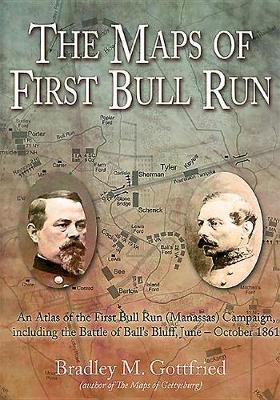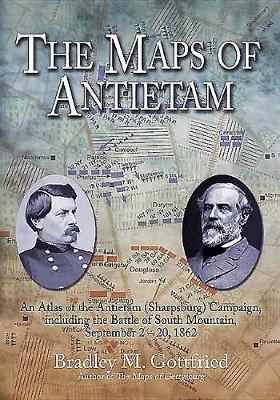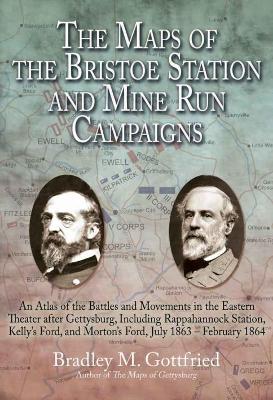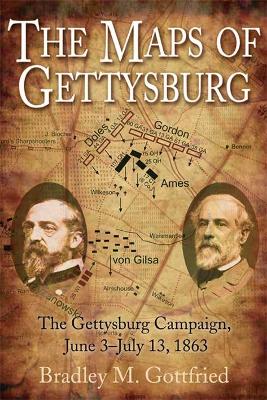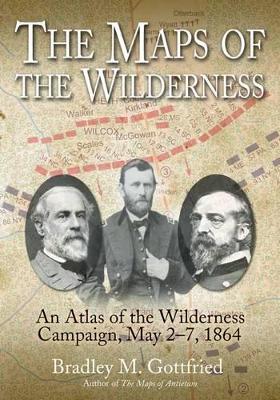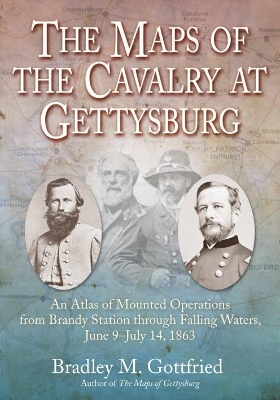Savas Beatie Military Atlas
7 total works
The Maps of First Bull Run, including the Battle of Ball's Bluff, June - October 1861 is the eagerly awaited companion volume to Gottfried's best-selling The Maps of Gettysburg (Savas Beatie, 2007), part of the ongoing Savas Beatie Atlas Series.
The Maps of First Bull Run breaks down the entire operation (and related actions) into numerous map sets or"action-sections" enriched with more than fifty full-colour original full-page maps. These cartographic originals bore down to the regimental and battery level and include the march to and from the battlefield and virtually every significant event in between. At least two-and as many as seventeen-maps accompany each "action-section". Keyed to each piece of cartography is detailed text describing the units, personalities, movements, and combat (including quotes from eyewitnesses) depicted on the accompanying map, all of which make the story of First Bull Run come alive.
This original presentation makes it easy for readers to quickly locate a map and text on virtually any portion of the campaign. Readers will manoeuvre with Confederate and Union armies in the Shenandoah Valley, march with General McDowell's Federals to the plains of Manassas, and fight blow-by-blow through the battle up to its stunning climax on Henry House Hill and the final retreat from the battlefield all the way to Washington. The smaller but important Battle of Ball's Bluff is also covered in the same detail, as is the skirmish at Lewinsville. Serious students will appreciate the extensive and authoritative endnotes, bibliography, and complete orders of battle.
Perfect for the easy chair or for walking hallowed ground, The Maps of First Bull Run is a seminal work that belongs on the bookshelf of every serious and casual student of the Civil War.
The Maps of First Bull Run breaks down the entire operation (and related actions) into numerous map sets or"action-sections" enriched with more than fifty full-colour original full-page maps. These cartographic originals bore down to the regimental and battery level and include the march to and from the battlefield and virtually every significant event in between. At least two-and as many as seventeen-maps accompany each "action-section". Keyed to each piece of cartography is detailed text describing the units, personalities, movements, and combat (including quotes from eyewitnesses) depicted on the accompanying map, all of which make the story of First Bull Run come alive.
This original presentation makes it easy for readers to quickly locate a map and text on virtually any portion of the campaign. Readers will manoeuvre with Confederate and Union armies in the Shenandoah Valley, march with General McDowell's Federals to the plains of Manassas, and fight blow-by-blow through the battle up to its stunning climax on Henry House Hill and the final retreat from the battlefield all the way to Washington. The smaller but important Battle of Ball's Bluff is also covered in the same detail, as is the skirmish at Lewinsville. Serious students will appreciate the extensive and authoritative endnotes, bibliography, and complete orders of battle.
Perfect for the easy chair or for walking hallowed ground, The Maps of First Bull Run is a seminal work that belongs on the bookshelf of every serious and casual student of the Civil War.
The Maps of Antietam breaks down the entire operation into 21 map sets or "action-sections" enriched with 124 full-colour original full-page maps. These spectacular cartographic creations bore down to the regimental and battery level and include the march into Maryland, the Harpers Ferry Operation, the Battle of South Mountain, the battle at Antietam, the retreat, and the fighting at Shepherdstown, as well as important marches and events. Each "action-section" is accompanied by as many as ten maps, and opposite each map is a full facing page of detailed, footnoted text describing the units, personalities, movements, and combat, including quotes from eyewitnesses, making the story of Lee's raid into Maryland come alive. This original presentation masterfully leads readers on a journey through the campaign that many historians believe marked the beginning of the end for the Confederacy. Gottfried begins with the position of the opposing armies after the Second Bull Run Campaign before detailing their joint movements into Maryland. Readers will stand with D. H.
Hill atop South Mountain as General McClellan tries to force his way through the mountain passes; surround, lay siege to, and capture Harpers Ferry (and ride with Col. Benjamin Davis's cavalry on its breakout); fight blow-by-blow outside the small town of Sharpsburg (53 maps) through the bloodiest day in American history; retreat from the battlefield; and revisit the final bloodshed spilled at Shepherdstown. Perfect for the easy chair or for walking hallowed ground, The Maps of Antietam is a seminal work that, like Gottfried's earlier Gettysburg and First Bull Run studies, belongs on the bookshelf of every serious and casual student of the Civil War.
Hill atop South Mountain as General McClellan tries to force his way through the mountain passes; surround, lay siege to, and capture Harpers Ferry (and ride with Col. Benjamin Davis's cavalry on its breakout); fight blow-by-blow outside the small town of Sharpsburg (53 maps) through the bloodiest day in American history; retreat from the battlefield; and revisit the final bloodshed spilled at Shepherdstown. Perfect for the easy chair or for walking hallowed ground, The Maps of Antietam is a seminal work that, like Gottfried's earlier Gettysburg and First Bull Run studies, belongs on the bookshelf of every serious and casual student of the Civil War.
The Maps of the Bristoe Station and Mine Run Campaigns
by Bradley M. Gottfried
Published 20 October 2013
The Maps of the Bristoe Station and Mine Run Campaigns is the fifth installment in the Savas Beatie Military Atlas Series.
Few historians have examined what happened to the Army of Northern Virginia and the Army of the Potomac during the critical months following Gettysburg, when both armies assumed the offensive in a pair of fascinating campaigns of thrust and counter-thrust. This careful study breaks down these campaigns (and all related operational maneuvers) into 13 map sets or“action-sections” enriched with 87 original full-page colour maps. These spectacular cartographic creations bore down to the regimental and battery level.
The Maps of the Bristoe Station and Mine Run Campaigns include the actions at Auburn and Bristoe Station, where Meade’s II Corps was nearly trapped and destroyed and the Confederates were caught by surprise and slaughtered; the seminal actions at Rappahannock Station and Kelly’s Ford, where portions of Lee’s army were surprised and overwhelmed; and the Mine Run Campaign, including the battle at Payne’s Farm, where an aggressive Confederate division held back two full Federal corps and changed the course of the entire campaign.
At least one—and as many as twelve—maps accompany each“action-section.” Opposite each map is a full facing page of detailed text with footnotes describing the units, personalities, movements, and combat (including quotes from eyewitnesses) depicted on the accompanying map, all of which make the story of these campaigns come alive.
Perfect for the easy chair or for walking hallowed ground, The Maps of the Bristoe Station and Mine Run Campaigns is a seminal work that, like Gottfried’s earlier atlases on Gettysburg, First Bull Run, and Antietam, belongs on the bookshelf of every serious and casual student of the Civil War.
Few historians have examined what happened to the Army of Northern Virginia and the Army of the Potomac during the critical months following Gettysburg, when both armies assumed the offensive in a pair of fascinating campaigns of thrust and counter-thrust. This careful study breaks down these campaigns (and all related operational maneuvers) into 13 map sets or“action-sections” enriched with 87 original full-page colour maps. These spectacular cartographic creations bore down to the regimental and battery level.
The Maps of the Bristoe Station and Mine Run Campaigns include the actions at Auburn and Bristoe Station, where Meade’s II Corps was nearly trapped and destroyed and the Confederates were caught by surprise and slaughtered; the seminal actions at Rappahannock Station and Kelly’s Ford, where portions of Lee’s army were surprised and overwhelmed; and the Mine Run Campaign, including the battle at Payne’s Farm, where an aggressive Confederate division held back two full Federal corps and changed the course of the entire campaign.
At least one—and as many as twelve—maps accompany each“action-section.” Opposite each map is a full facing page of detailed text with footnotes describing the units, personalities, movements, and combat (including quotes from eyewitnesses) depicted on the accompanying map, all of which make the story of these campaigns come alive.
Perfect for the easy chair or for walking hallowed ground, The Maps of the Bristoe Station and Mine Run Campaigns is a seminal work that, like Gottfried’s earlier atlases on Gettysburg, First Bull Run, and Antietam, belongs on the bookshelf of every serious and casual student of the Civil War.
Thousands of books and articles have been written about Gettysburg, but the operation remains one of the most complex and difficult to understand. Bradley Gottfried’s The Maps of Gettysburg: An Atlas of the Gettysburg Campaign, June 3 - July 13, 1863 is a unique and thorough study of this multifaceted campaign.
The Maps of Gettysburg breaks down the entire operation into thirty map sets or“action-sections” enriched with 144 detailed full-page maps comprising the entire campaign. These cartographic originals bore down to the regimental and battery level and include the march to and from the battlefield and virtually every significant event in between. At least two—and as many as twenty—maps accompany each map set. Keyed to each piece of cartography is a full facing page of detailed text describing the units, personalities, movements, and combat (including quotes from eyewitnesses) depicted on the accompanying map, all of which makes the Gettysburg story come alive.
This presentation makes it easy for readers to quickly locate a map and text on virtually any portion of the campaign, from the march into Pennsylvania during June to the last Confederate withdrawal of troops across the Potomac River on July 13, 1863. Serious students of the battle will appreciate the extensive and authoritative endnotes and complete order of battle. They will also want to bring the book along on their trips to the battlefield.
Perfect for the easy chair or for stomping the hallowed ground of Gettysburg, The Maps of Gettysburg is a seminal work that belongs on the bookshelf of every serious and casual student of the battle.
The Maps of Gettysburg breaks down the entire operation into thirty map sets or“action-sections” enriched with 144 detailed full-page maps comprising the entire campaign. These cartographic originals bore down to the regimental and battery level and include the march to and from the battlefield and virtually every significant event in between. At least two—and as many as twenty—maps accompany each map set. Keyed to each piece of cartography is a full facing page of detailed text describing the units, personalities, movements, and combat (including quotes from eyewitnesses) depicted on the accompanying map, all of which makes the Gettysburg story come alive.
This presentation makes it easy for readers to quickly locate a map and text on virtually any portion of the campaign, from the march into Pennsylvania during June to the last Confederate withdrawal of troops across the Potomac River on July 13, 1863. Serious students of the battle will appreciate the extensive and authoritative endnotes and complete order of battle. They will also want to bring the book along on their trips to the battlefield.
Perfect for the easy chair or for stomping the hallowed ground of Gettysburg, The Maps of Gettysburg is a seminal work that belongs on the bookshelf of every serious and casual student of the battle.
The Maps of the Wilderness: An Atlas of the Wilderness Campaign, May 2-7, 1864 continues Bradley M. Gottfried’s efforts to study and illustrate the major campaigns of the Civil War’s Eastern Theater. This is his fifth book in the ongoing Savas Beatie Military Atlas Series. The previous four were The Maps of Gettysburg (2007), The Maps of First Bull Run (2009), The Maps of Antietam (2012), and The Maps of the Bristoe Station and Mine Run Campaigns (2013).
The Maps of the Cavalry at Gettysburg: An Atlas of Mounted Operations from Brandy Station Through Falling Waters, June 9 - July 14, 1863 continues Bradley M. Gottfried’s efforts to study and illustrate the major campaigns of the Civil War’s Eastern Theater. This is his seventh book in the ongoing Savas Beatie Military Atlas Series.
The Maps of Gettysburg, Gottfried’s inaugural and groundbreaking atlas published in 2007, covered only a small portion of the cavalry’s actions during the seminal campaign. This book addresses that topic in-depth in a way that no other study has ever achieved. Gottfried covers the opening battle of the campaign at Brandy Station in detail, followed by the actions at Aldie, Middleburg, and Upperville, where Jeb Stuart’s cavalry successfully halted Alfred Pleasonton’s probes toward the Blue Mountain passes in an effort to determine the location of Robert E. Lee’s army. The movements toward Gettysburg are covered in a series of maps, including the actions at Westminister, Hanover, and Hunterstown. The five major actions on July 2-3 at Gettysburg take up a considerable portion of the book and include the fight at Brinkerhoff Ridge, and four more on July 3 (Stuart against David Gregg northeast of the town, Wesley Merritt’s fight along Emmitsburg Road, Judson Kilpatrick’s actions near the base of Big Round Top, and Grumble Jones’s near-destruction of the 6th U.S. Cavalry near Fairfield).
The cavalry also played a vital role during Lee’s retreat to the Potomac River. The numerous fights at Monterrey Pass, Smithfield, Boonsboro, Funkstown, and Hagerstown were of critical importance to both sides and are covered in detail. The book concludes with the fight at Falling Waters and ends with an epilogue recounting events occurring in Virginia through the end of July.
The Maps of the Cavalry at Gettysburg plows new ground by breaking down the entire campaign into sixteen map sets or “action sections,” enriched with 82 detailed full-page color maps. These cartographic originals bore down to the regimental and battery level, and include the march to and from the battlefield and virtually every significant event in between. At least two—and as many as ten—maps accompany each map set. Keyed to each piece of cartography is a full-facing page of detailed text describing the units, personalities, movements, and combat (including quotes from eyewitnesses) depicted on the accompanying map, all of which make the cavalry actions come alive.
This presentation allows readers to easily and quickly find a map and text on virtually any portion of the campaign. Serious students will appreciate the extensive and authoritative endnotes and complete order of battle, and take it with them on trips to the battlefields. A final bonus is that the maps unlock every other book or article written on any aspect of the cavalry’s actions during this important campaign.
Perfect for the easy chair or for stomping the hallowed grounds, The Maps of the Cavalry at Gettysburg is a seminal work that belongs on the bookshelf of every serious and casual student of the battle.
The Maps of Gettysburg, Gottfried’s inaugural and groundbreaking atlas published in 2007, covered only a small portion of the cavalry’s actions during the seminal campaign. This book addresses that topic in-depth in a way that no other study has ever achieved. Gottfried covers the opening battle of the campaign at Brandy Station in detail, followed by the actions at Aldie, Middleburg, and Upperville, where Jeb Stuart’s cavalry successfully halted Alfred Pleasonton’s probes toward the Blue Mountain passes in an effort to determine the location of Robert E. Lee’s army. The movements toward Gettysburg are covered in a series of maps, including the actions at Westminister, Hanover, and Hunterstown. The five major actions on July 2-3 at Gettysburg take up a considerable portion of the book and include the fight at Brinkerhoff Ridge, and four more on July 3 (Stuart against David Gregg northeast of the town, Wesley Merritt’s fight along Emmitsburg Road, Judson Kilpatrick’s actions near the base of Big Round Top, and Grumble Jones’s near-destruction of the 6th U.S. Cavalry near Fairfield).
The cavalry also played a vital role during Lee’s retreat to the Potomac River. The numerous fights at Monterrey Pass, Smithfield, Boonsboro, Funkstown, and Hagerstown were of critical importance to both sides and are covered in detail. The book concludes with the fight at Falling Waters and ends with an epilogue recounting events occurring in Virginia through the end of July.
The Maps of the Cavalry at Gettysburg plows new ground by breaking down the entire campaign into sixteen map sets or “action sections,” enriched with 82 detailed full-page color maps. These cartographic originals bore down to the regimental and battery level, and include the march to and from the battlefield and virtually every significant event in between. At least two—and as many as ten—maps accompany each map set. Keyed to each piece of cartography is a full-facing page of detailed text describing the units, personalities, movements, and combat (including quotes from eyewitnesses) depicted on the accompanying map, all of which make the cavalry actions come alive.
This presentation allows readers to easily and quickly find a map and text on virtually any portion of the campaign. Serious students will appreciate the extensive and authoritative endnotes and complete order of battle, and take it with them on trips to the battlefields. A final bonus is that the maps unlock every other book or article written on any aspect of the cavalry’s actions during this important campaign.
Perfect for the easy chair or for stomping the hallowed grounds, The Maps of the Cavalry at Gettysburg is a seminal work that belongs on the bookshelf of every serious and casual student of the battle.
The Maps of Spotsylvania through Cold Harbor continues Bradley M. Gottfried's efforts to study and illustrate the major campaigns of the Civil War's Eastern Theater. This is the eighth book in the ongoing Savas Beatie Military Atlas Series.
After three years of bloody combat with no clear victor in the Virginia theater, President Abraham Lincoln turned to Ulysses S. Grant and promoted him to general-in-chief during the winter of 1863-64. Grant immediately went to work planning a comprehensive strategy to bring an end to the war. He hungered to remain with the Western armies, but realized his place was in Washington. Unwilling to be stuck in an office, Grant joined George Meade's Army of the Potomac. His presence complicated Meade's ability to direct his army, but Grant promised to stay out of his way and give only strategic directives. This arrangement lasted through the Wilderness Campaign, the first action in what is now referred to as the "Overland Campaign."
This book continues the actions of both armies through the completion of the Overland Campaign. After the Wilderness fighting, the Army of the Potomac attempted to swing around the left flank of Gen. Robert E. Lee's Army of Northern Virginia and shoot straight for Richmond. The Confederate capital was never the goal; the move was intended to force Lee out into the open, where the larger and well-stocked Union army could destroy it.
The head of Lee's army reached Spotsylvania Court House in time to blunt Meade's march and both sides threw up extensive defensive works. Days and men were wasted on fruitless attacks until Col. Emery Upton designed an audacious strike that temporarily penetrated Lee's works. A much larger offensive through the early dawn fog against the "Mule Shoe" tore the line wide open, destroyed a Confederate division, and triggered an entire day of fighting before Lee was able to stabilize his front.
More fighting convinced Grant of the folly of further attempts to crush Lee at Spotsylvania and again he swung around the Confederate left flank. The march ignited almost continuous fighting along the North Anna River, Bethesda Church, and Cold Harbor, where this volume ends. This study also included the many cavalry actions, including those at Spotsylvania Court House, Yellow Tavern, Haw's Tavern, and Matadequin Creek.
The Maps of Spotsylvania through Cold Harbor breaks down the entire operation into thirty-five map sets or "action sections" enriched with 134 detailed full-page color maps. These cartographic originals bore down to the regimental and battery level and include the march to and from the battlefields and virtually every significant event in between. At least two, and as many as ten maps accompany each map set. Keyed to each piece of cartography is a full facing page of detailed footnoted text describing the units, personalities, movements, and combat (including quotes from eyewitnesses) depicted on the accompanying map, all of which make the Spotsylvania story come alive.
This unique presentation allows readers to easily and quickly find a map and text on any portion of the campaign, from the march to Spotsylvania Court House to Cold Harbor. Serious students of the battle will appreciate the extensive and authoritative endnotes and complete order of battle. Everyone will want to take the book along on trips to these battlefields.
Perfect for the easy chair or for stomping the hallowed ground, The Maps of Spotsylvania through Cold Harbor is a seminal work that belongs on the bookshelf of every serious and casual student of the battle.
Previous titles in this series include: The Maps of Gettysburg (2007), The Maps of First Bull Run (2009), The Maps of Chickamauga (by David A. Powell and David A Freidrichs), The Maps of Antietam (2012), The Maps of Bristoe Station and Mine Run (2013), the Maps of the Wilderness (2016), and The Maps of the Cavalry in the Gettysburg Campaign (2020).
After three years of bloody combat with no clear victor in the Virginia theater, President Abraham Lincoln turned to Ulysses S. Grant and promoted him to general-in-chief during the winter of 1863-64. Grant immediately went to work planning a comprehensive strategy to bring an end to the war. He hungered to remain with the Western armies, but realized his place was in Washington. Unwilling to be stuck in an office, Grant joined George Meade's Army of the Potomac. His presence complicated Meade's ability to direct his army, but Grant promised to stay out of his way and give only strategic directives. This arrangement lasted through the Wilderness Campaign, the first action in what is now referred to as the "Overland Campaign."
This book continues the actions of both armies through the completion of the Overland Campaign. After the Wilderness fighting, the Army of the Potomac attempted to swing around the left flank of Gen. Robert E. Lee's Army of Northern Virginia and shoot straight for Richmond. The Confederate capital was never the goal; the move was intended to force Lee out into the open, where the larger and well-stocked Union army could destroy it.
The head of Lee's army reached Spotsylvania Court House in time to blunt Meade's march and both sides threw up extensive defensive works. Days and men were wasted on fruitless attacks until Col. Emery Upton designed an audacious strike that temporarily penetrated Lee's works. A much larger offensive through the early dawn fog against the "Mule Shoe" tore the line wide open, destroyed a Confederate division, and triggered an entire day of fighting before Lee was able to stabilize his front.
More fighting convinced Grant of the folly of further attempts to crush Lee at Spotsylvania and again he swung around the Confederate left flank. The march ignited almost continuous fighting along the North Anna River, Bethesda Church, and Cold Harbor, where this volume ends. This study also included the many cavalry actions, including those at Spotsylvania Court House, Yellow Tavern, Haw's Tavern, and Matadequin Creek.
The Maps of Spotsylvania through Cold Harbor breaks down the entire operation into thirty-five map sets or "action sections" enriched with 134 detailed full-page color maps. These cartographic originals bore down to the regimental and battery level and include the march to and from the battlefields and virtually every significant event in between. At least two, and as many as ten maps accompany each map set. Keyed to each piece of cartography is a full facing page of detailed footnoted text describing the units, personalities, movements, and combat (including quotes from eyewitnesses) depicted on the accompanying map, all of which make the Spotsylvania story come alive.
This unique presentation allows readers to easily and quickly find a map and text on any portion of the campaign, from the march to Spotsylvania Court House to Cold Harbor. Serious students of the battle will appreciate the extensive and authoritative endnotes and complete order of battle. Everyone will want to take the book along on trips to these battlefields.
Perfect for the easy chair or for stomping the hallowed ground, The Maps of Spotsylvania through Cold Harbor is a seminal work that belongs on the bookshelf of every serious and casual student of the battle.
Previous titles in this series include: The Maps of Gettysburg (2007), The Maps of First Bull Run (2009), The Maps of Chickamauga (by David A. Powell and David A Freidrichs), The Maps of Antietam (2012), The Maps of Bristoe Station and Mine Run (2013), the Maps of the Wilderness (2016), and The Maps of the Cavalry in the Gettysburg Campaign (2020).
